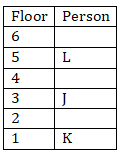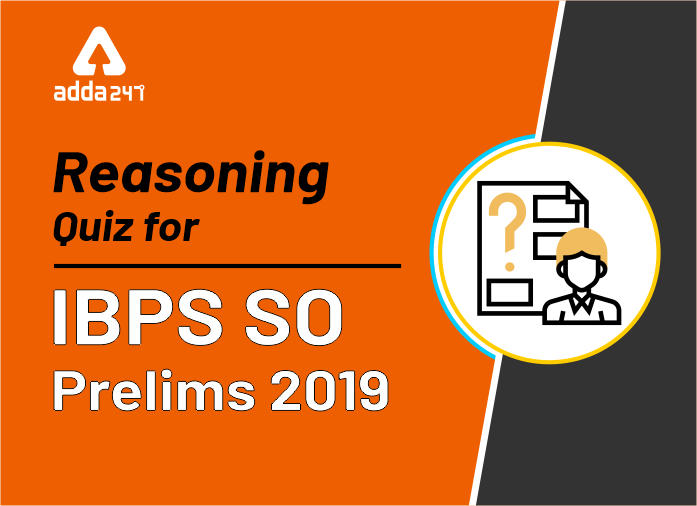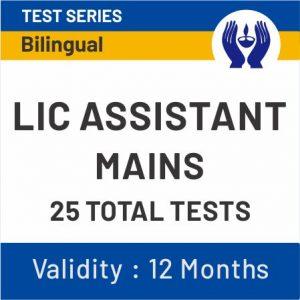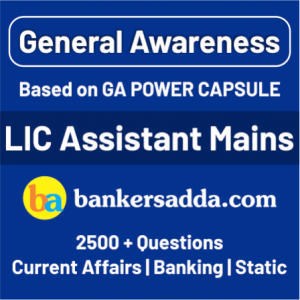Reasoning Ability is an onerous section. With the increasing complexity of questions, it becomes hard for one to give it the cold shoulder. And, to let you practice with the best of the latest pattern questions we will provide a proper study Plan for IBPS SO 2019 exam. Bankeradda also provides daily quizzes of Reasoning Ability for practice as the IBPS SO Prelims is scheduled for 28th and 29th December 2019. So practice to sail through IBPS SO Exam
Directions (1-5): Study the following information carefully and answer the questions given below:
Eight persons are sitting in a row but not necessarily in the same order. Only three persons face south direction. All of them are of different ages i.e. 49, 28, 36, 84, 16, 18, 77, and 37 but not necessarily in the same order. Four persons sit between G and D. C sits immediate left of E and C’s age is perfect square as well as an odd number. D’s age is a perfect square and sits third right of C. B sits right of C. F is three times older than H. D’s age is double of A’s age. E sits third from the extreme end of the row and he is second oldest person of the group. B’s age is perfect square as well as an even number. C and G both face same direction. A sits fourth left of C. E face south direction. C and G are immediate neighbors of F. B is younger than D. C does not sit immediate right of E.
Q1. Who among the following is 16years old?
(a) G
(b) A
(c) the one who sits third to the left of F
(d) D
(e) the one who sits second right of the one who is 36years old
Q2. Who among the following sits second to the right of D?
(a) B
(b) E
(c) G
(d) A
(e) F
Q3. Which of the following statement is true about H?
(a) H sits third from the right end
(b) H is fourth oldest person
(c) H sits immediate right of G
(d) Age difference between H and A is 10years
(e) All are true
Q4. What is the position of E with respect to G?
(a) Immediate left
(b) Second to the right
(c) Fourth to the left
(d) Immediate right
(e) third to the right
Q5. Who among the following is 21years younger than C?
(a) H
(b) D
(c) E
(d) F
(e) G
Direction (6-10): In these questions, relationship between different elements is show in the statements. The statements are followed by conclusions. Study the conclusions based on the given statements and select the appropriate answer:
Q6.
Statements: M≤R<Y≥P>X<S=G>L>W
Conclusion I: W≤Y II: P>G
(a) If only conclusion I follows.
(b) If only conclusion II follows.
(c) If either conclusion I or II follows
(d) If neither conclusion I nor II follows.
(e) If both conclusions I and II follow.
Q7.
Statements: T>Y=C>K≥D≥R=A≤Z
Conclusion I: C=A II: C>A
(a) If only conclusion I follows.
(b) If only conclusion II follows.
(c) If either conclusion I or II follows
(d) If neither conclusion I nor II follows.
(e) If both conclusions I and II follow.
Q8.
Statements: M>V>B≥U=O>S>W≤D<Q
Conclusion I: D>B II: D≤B
(a) If only conclusion I follows.
(b) If only conclusion II follows.
(c) If either conclusion I or II follows
(d) If neither conclusion I nor II follows.
(e) If both conclusions I and II follow.
Q9.
Statements: T=R≥J≥L=C<D≤S
Conclusion I: R>S II: C≤T
(a) If only conclusion I follows.
(b) If only conclusion II follows.
(c) If either conclusion I or II follows
(d) If neither conclusion I nor II follows.
(e) If both conclusions I and II follow.
Q10.
Statements: Z≥D> E=R<P=Y≤U>O
Conclusion I: U>R II: Z>R
(a) If only conclusion I follows.
(b) If only conclusion II follows.
(c) If either conclusion I or II follows
(d) If neither conclusion I nor II follows.
(e) If both conclusions I and II follow.
Directions (11-15): Each of the questions below consists of a question and two statements numbered I and II given below it. You have to decide whether the data provided in the statement are sufficient to answer the question. Read both the statements and Give answer:
Q11. Among P, Q, R, S, T and U each one of them has different age, who is the third eldest person?
I. S is elder than Q and P. S is younger than only T.
II. P is not the youngest. Q is younger than U but elder than P.
(a) If the data in statement I alone are sufficient to answer the question, while the data in statement II alone are not sufficient to answer the question.
(b) If the data in statement II alone are sufficient to answer the question, while the data in statement I alone are not sufficient to answer the question.
(c) If the data either in statement I alone or in statement II alone are sufficient to answer the question.
(d) If the data even in both statements I and II together are not sufficient to answer the question.
(e) If the data in both statements I and II together are necessary to answer the question.
Q12. Six boxes A, B, C, D, E and F are placed one above another. Which of the following box is placed second from the top?
I: C is placed above box E. Two boxes are placed between box C and box D
II: A is placed above box C. Box D is placed below Box B
(a) If the data in statement I alone are sufficient to answer the question, while the data in statement II alone are not sufficient to answer the question.
(b) If the data in statement II alone are sufficient to answer the question, while the data in statement I alone are not sufficient to answer the question.
(c) If the data either in statement I alone or in statement II alone are sufficient to answer the question.
(d) If the data even in both statements I and II together are not sufficient to answer the question.
(e) If the data in both statements I and II together are necessary to answer the question.
Q13. Among J, K, L, M, N and P each one of them live at six different floors of the same building, who among the following live at 3rd floor?
I: J lives at one of the odd numbered floors. K lives at bottom floor. L lives at 5th floor.
II: M lives at top floor. N lives at 4th floor.
(a) If the data in statement I alone are sufficient to answer the question, while the data in statement II alone are not sufficient to answer the question.
(b) If the data in statement II alone are sufficient to answer the question, while the data in statement I alone are not sufficient to answer the question.
(c) If the data either in statement I alone or in statement II alone are sufficient to answer the question.
(d) If the data even in both statements I and II together are not sufficient to answer the question.
(e) If the data in both statements I and II together are necessary to answer the question.
Q14. What is the code of black?
I: If “white blue black” is coded as “il kc ue” and “black green white” is coded as “ue ne il”
II: If “black yellow Orange” is coded as “ow rn lb” and “green black white” (a) If the data in statement I alone are sufficient to answer the question, while the data in statement II alone are not sufficient to answer the question.
(b) If the data in statement II alone are sufficient to answer the question, while the data in statement I alone are not sufficient to answer the question.
(c) If the data either in statement I alone or in statement II alone are sufficient to answer the question.
(d) If the data even in both statements I and II together are not sufficient to answer the question.
(e) If the data in both statements I and II together are necessary to answer the question.
Q15. Which of the following statement define N≥P?
I: K<L≤P, M=Q, P=O≤M, Q≤N
II: M>Q=P≤R, N=T≥R
(a) If the data in statement I alone are sufficient to answer the question, while the data in statement II alone are not sufficient to answer the question.
(b) If the data in statement II alone are sufficient to answer the question, while the data in statement I alone are not sufficient to answer the question.
(c) If the data either in statement I alone or in statement II alone are sufficient to answer the question.
(d) If the data even in both statements I and II together are not sufficient to answer the question.
(e) If the data in both statements I and II together are necessary to answer the question.
Sol. (1-5):

S1. Ans.(c)
S2. Ans.(b)
S3. Ans.(d)
S4. Ans.(e)
S5. Ans.(a)
Solutions (6-10):
S6. Ans(d)
Sol. I: W≤Y(False) II: P>G(False)
S7. Ans(b)
Sol. I: C=A (False) II: C>A (True)
S8. Ans(c)
Sol. I: D>B (False) II: D≤B (False)
S9. Ans(b)
Sol. I: R>S (False) II: C≤T (True)
S10. Ans(e)
Sol. I: U>R (True) II: Z>R (True)
Sol. (11-15):
S11. Ans(e)
Sol.
Combine I and II
T>S>U>Q>P>R
S12. Ans (d)
S13. Ans (a)
From statement I:

And statement II has insufficient data
S14. Ans (b)
Sol.
From statement I:
“Black” is coded as “ue/il”
From statement II:
“Black” is coded as “ow”
S15. Ans (c)
Sol.
From statement I:
K<L≤P=O≤M=Q≤N
From statement II:
M>Q=P≤R≤T=N




 Reasoning Quiz For Bank Foundation 2024 ...
Reasoning Quiz For Bank Foundation 2024 ...
 Reasoning Quiz For Bank Foundation 2024 ...
Reasoning Quiz For Bank Foundation 2024 ...



